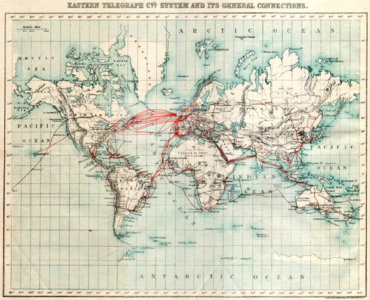Portal:Telecommunication
The Telecommunication Portal

Telecommunication, often used in its plural form, is the transmission of information with an immediacy comparable to face-to-face communication. As such, slow communications technologies like postal mail and pneumatic tubes are excluded from the definition. Many transmission media have been used for telecommunications throughout history, from smoke signals, beacons, semaphore telegraphs, signal flags, and optical heliographs to wires and empty space made to carry electromagnetic signals. These paths of transmission may be divided into communication channels for multiplexing, allowing for a single medium to transmit several concurrent communication sessions. Several methods of long-distance communication before the modern era used sounds like coded drumbeats, the blowing of horns, and whistles. Long-distance technologies invented during the 20th and 21st centuries generally use electric power, and include the telegraph, telephone, television, and radio.
Early telecommunication networks used metal wires as the medium for transmitting signals. These networks were used for telegraphy and telephony for many decades. In the first decade of the 20th century, a revolution in wireless communication began with breakthroughs including those made in radio communications by Guglielmo Marconi, who won the 1909 Nobel Prize in Physics. Other early pioneers in electrical and electronic telecommunications include co-inventors of the telegraph Charles Wheatstone and Samuel Morse, numerous inventors and developers of the telephone including Antonio Meucci and Alexander Graham Bell, inventors of radio Edwin Armstrong and Lee de Forest, as well as inventors of television like Vladimir K. Zworykin, John Logie Baird and Philo Farnsworth.
Since the 1960s, the proliferation of digital technologies has meant that voice communications have gradually been supplemented by data. The physical limitations of metallic media prompted the development of optical fibre. The Internet, a technology independent of any given medium, has provided global access to services for individual users and further reduced location and time limitations on communications. (Full article...)
Selected article -

In the nineteenth century, the United Kingdom of Great Britain and Ireland had the world's first commercial telegraph company. British telegraphy dominated international telecommunications well into the twentieth. Telegraphy is the sending of textual messages by human operators using symbolic codes. Electrical telegraphy used conducting wires to send messages, often incorporating a telegram service to deliver the telegraphed communication from the telegraph office. This is distinct from optical telegraphy that preceded it and the radiotelegraphy that followed. Though Francis Ronalds first demonstrated a working telegraph over a substantial distance in 1816, he was unable to put it into practical use. Starting in 1836, William Fothergill Cooke, with the scientific assistance of Charles Wheatstone, developed the Cooke and Wheatstone telegraph. The needle telegraph instrument suggested by Wheatstone, the battery invented by John Frederic Daniell, and the relay invented by Edward Davy were important components of this system.
In 1846, Cooke and financier John Lewis Ricardo formed the Electric Telegraph Company which initially supplied telegraph systems to railway companies but soon branched out into other businesses, slowly building a network that could be used by the public. Many competing companies arose; the most important of them was the Magnetic Telegraph Company (the "Magnetic") formed in 1850. They used the telegraph invented by William Thomas Henley, which did not require batteries. The Electric and Magnetic companies soon formed a cartel to control the market. They were profitable, but most other companies were not. (Full article...)General images
Things to do
 |
Here are some tasks awaiting attention:
|
Selected biography -
Antonio Santi Giuseppe Meucci (/meɪˈuːtʃi/ may-OO-chee, Italian: [anˈtɔːnjo meˈuttʃi]; 13 April 1808 – 18 October 1889) was an Italian inventor and an associate of Giuseppe Garibaldi, a major political figure in the history of Italy. Meucci is best known for developing a voice-communication apparatus that several sources credit as the first telephone.
Meucci set up a form of voice-communication link in his Staten Island, New York, home that connected the second-floor bedroom to his laboratory. He submitted a patent caveat for his telephonic device to the U.S. Patent Office in 1871, but there was no mention of electromagnetic transmission of vocal sound in his caveat. In 1876, Alexander Graham Bell was granted a patent for the electromagnetic transmission of vocal sound by undulatory electric current. Despite the longstanding general crediting of Bell with the accomplishment, the Italian Ministry of Cultural Heritage and Activities supported celebrations of Meucci's 200th birthday in 2008 using the title "Inventore del telefono" (Inventor of the telephone). The U.S. House of Representatives in a resolution in 2002 also acknowledged Meucci's work in the invention of the telephone, although the U.S. Senate did not join the resolution and the interpretation of the resolution is disputed. (Full article...)Did you know (auto-generated) -

- ... that Homestead, Florida, radio station WOIR was credited with saving the lives of hundreds of farmworkers in a labor camp before the arrival of Hurricane Andrew?
- ... that reporter Bobbie Wygant got her first television show after filling in while its host was sick with the flu?
- ... that Sunday-school classes were once held in the transmitter building of New Mexico radio station KCLV?
- ... that the first studio of Indiana high school radio station WETL was a cedar closet that had once stored furs?
- ... that the Voice of Freedom had to counter venomous snakes, leeches, and other wildlife?
- ... that for more than a decade, WNJC-FM at Northwest Mississippi Junior College was the state's only public radio station?
Related portals
Topics
Subcategories
Associated Wikimedia
The following Wikimedia Foundation sister projects provide more on this subject:
-
Commons
Free media repository -
Wikibooks
Free textbooks and manuals -
Wikidata
Free knowledge base -
Wikinews
Free-content news -
Wikiquote
Collection of quotations -
Wikisource
Free-content library -
Wikiversity
Free learning tools -
Wiktionary
Dictionary and thesaurus




























































































